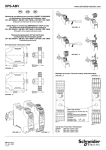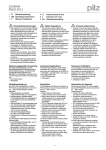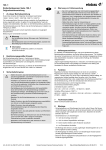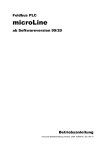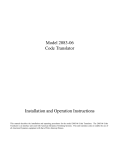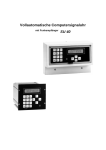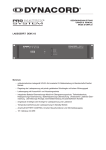Download HR1S-AF SAFETY RELAY MODULE OPERATING INSTRUCTIONS
Transcript
HR1S-AF FR GB SAFETY RELAY MODULE OPERATING INSTRUCTIONS DE HR1S-AF....P Module de surveillance pour circuits d'ARRET D'URGENCE selon EN 418 / EN 60204-1 HR1S-AF.... Safety relay for monitoring EMERGENCY STOP circuits according to EN 418 / EN 60204-1 Überwachungsbaustein für NOT AUS Kreise gemäß EN 418 / EN 60204-1 Encombrements / Dimensions / Maße 24 33 13 23 3 S34 S39 A1 S3 id ec H R 1S 24 33 13 233 S34 S39 A1 S3 id ec K2 Fuse 33 13 23 99 mm (3.89 in) K1 K1 K2 34 14 24 E K1 TY UL E SA FE Y M OD RE LA A1/A2 K2 -A F Fuse -A F 33 13 23 H R 1S TY UL SA FE Y M OD RE LA A1/A2 K1 K2 34 14 24 1 S12 A2 S11 S22 34 14 S2 S1234 2 S11S22 A 4 S21 Repérage des bornes Terminal marking Klemmenanzeiger 22.5 mm (0.89 in) 114 mm (4.48 in) HR1S-AF.... 99 mm (3.89 in) 13 23 24 33 A1 S33 S34 S39 A2 S11 S12 14 S21 S22 34 13 23 24 33 A1 S33 S34 S39 A2 S11 S12 14 S21 S22 34 HR1S-AF....P 114 mm (4.48 in) 22.5 mm (0.89 in) HR1S-AF.... HR1S-AF....P HR1S-AF....P Application Le module HR1S-AF sert à interrompre en toute sécurité un ou plusieurs circuits. Il est conçu pour être intégré aux circuits d'arrêt d'urgence ou de sécurité selon EN 60204-1. Il satisfait aux exigences des normes européennes EN 418 pour les arrêts d'urgence et EN 60204-1 pour les circuits de sécurité. Ces normes concernent en particulier les cas où une seule commande doit couper plusieurs circuits (arrêt d'urgence à action indirecte). Le module répond également aux exigences de sécurité pour la surveillance électrique des interrupteurs de position actionnés par des dispositifs de protection. Le module est équipé de trois sorties de sécurité, libres de potentiel,de catégorie d'arrêt 0 (EN 418, EN 60204-1). Le module est conçu pour l'utilisation d'entrée à une ou deux voies. Nous préconisons l'utilisation de deux voies d'entrée qui augmente ainsi le niveau de sécurité. Ce mode opératoire permet d'intégrer toute la connectique dans la surveillance. Tous les premiers défauts sont ainsi détectés. Fonction La tension d'alimentation est appliquée aux bornes A1/A2 selon la valeur sur la plaque signalétique. Les unités de commande sont raccordées de la façon suivante: L'utilisation d'une voie d'entrée : Les unités de commande doivent être connectées à la borne A1. Les bornes S11-S12 et S21-S22 doivent être shuntées. L'utilisation de deux voies d'entrée : Les unités de commande doivent être connectées aux bornes S11S12 et S21-S22. Pour un raccordement à deux voies, les deux circuits d'entrée sont alimentés des polarités différentes, ce qui permet la détection des courts-circuits entre le + et le -. 5/10 Si le bouton de démarrage est connecté entre les bornes S33-S34 (utilisation recommandée), les sorties du module sont activées sur le front descendant de l’impulsion du signal de sortie (lorsque le bouton de démarrage est relâché). La surveillance du bouton de démarrage correspond à la catégorie 4 de la norme EN 954-1 à condition que: - le bouton de démarrage soit raccordé entre les bornes S33-S34. - les fils de connection du bouton soient protégés contre les courts circuits. - un bouton à reset automatique avec signalisation visuelle de la position et approprié pour les conditios environnementales soit utilisé. Si le bouton de démarrage est connecté entre les bornes S33 et S39, les sorties sont activées dès l’actionnement du bouton de démarrage, à condition que les circuits d’entrée soient alors fermés. Il est également possible de shunter les bornes S33-S39. Les sorties sont ainsi activées dès que les deux signaux d’entrée entre les bornes S11-S12 et S21-S22 sont fermés. Le temps de synchronisation entre les deux circuits d’entrée est illimité. Les contacts d’ouverture des relais ou contacteurs connectés en aval des sorties de sécurité doivent être connectés en série avec le bouton de démarrage, aux bornes S33-S34 ou S33-S39. La mise en marche de l’appareil n’est ainsi possible que si les relais ou contacteurs connectés en aval qui ont une fonction relative à la sécurité sont devenus inactifs après avoir reçu l’ordre d’arrêt. La boucle de retour ainsi formée doit être fermée pour chaque nouvelle mise en marche. Un fusible électronique intégré protège le module contre la destruction par courts-circuits externes (par exemple court-circuit entre le + et le des circuits d'entrée). Après élimination du défaut, le module est prêt à être remis en service après quelques secondes. HR1S-AF ! SAFETY RELAY MODULE OPERATING INSTRUCTIONS Indications supplémentaires Le module ne contient pas de composants soumis à maintenance par l'utilisateur. Pour l'autorisation d'un circuit de sécurité selon EN 60204-1: 1992 / EN 418 il est impératif d'utiliser seulement les circuits de sortie libres de potentiel entre les bornes 13-14, 23-24 et 33-34. ! Risques résiduels (EN 292-1, article 5) An internal electronic fuse protects the module against destruction by external short circuits (e. g., short circuits between the + and the - of the input circuits). After elimination of the fault, the module is again operative after a few seconds. It is imperative that an external fuse be connected as shown on the "WIRING DIAGRAM FOR MODULE HR1S-AF SAFETY RELAY". For maximum protection of the outputs, please refer to "TECHNICAL DATA". Le schéma de raccordement proposé ci-dessous a été vérifié et testé avec le plus grand soin dans des conditions de mise en service. Des risques subsistent si : a) le schéma de câblage ci-dessous est modifié par changement des connexions ou l'adjonction de composants lorsque ceux-ci ne sont pas ou insuffisamment intégrés dans le circuit de sécurité. b) l'utilisateur ne respecte pas les exigences des normes de sécurité pour le service, le réglage et la maintenance de la machine. Il est important de respecter strictement les échéances de contrôle et de maintenance. Application Safety systems are comprised of many components. No one safety component will insure the safety of the system. The design of the complete safety system should be considered before you begin. It is very important to follow applicable safety standards when installing and wiring these components. The HR1S-AF module provides an interruption of one or several circuits and is designed to be integrated in emergency stop or safety circuits conforming to EN 60204-1. It meets the requirements of the European standard EN 418 for emergency stop equipment and EN 60204-1 for safety circuits in general. These standards concern applications where several circuits are opened by one single command (emergency stop by indirect action). The module also meets the safety requirements for electrical monitoring of limit switches in lieu of emergency stop. The module provides with three safety outputs of stop category 0 (EN 418, EN 60204-1). The module is designed for use with one or two input channels. Due to the extended possibilities of fault detection and resulting increased safety level we recommend the use of two input channels. In this operation mode the connection cables are included in the monitoring and all initial faults will be detected. ! Note There are no user serviceable components in the module. For safety circuits according to EN 60204-1:1992/EN418 safety devices must use only the hard contacts outputs between terminals 13-14, 23-24 and 3334. ! Residual Risk (EN 292-1, article 5) The following wiring diagram has been tested and tried carefully under actual service conditions. This module must be used for safety-related functions in conjunction with the connected safety equipment and devices that meet applicable standard requirements. A residual risk will remain if: a) it is necessary to modify this recommended circuit and if the added/ modified components are not properly integrated in the control circuit. b) the user does not follow the required standards applicable to the operation of the machine, or if the adjustments to and maintenance of the machine are not properly made. It is strictly necessary to follow the prescribed machine maintenance schedule. c) the user does not select relays K3 and K4 with mechanically-linked contacts. ! WARNING IMPROPER CIRCUIT AND MAINTENANCE HAZARD • • • • Wire safety relay using wiring diagram shown in following wiring diagram. Wire to meet applicable standards requirements. K3 and K4 must have mechanically-linked contacts. Strictly follow prescribed maintenance schedule when making adjustments to and maintenance of machine. Failure to follow these instructions can result in death or serious injury. Function Anwendungsbereich Use of one input channel: Connect the control unit contacts to terminal A1. Terminals S11-S12 and S21-S22 must be shunted. Das Gerät HR1S-AF dient dem sicherheitsgerichteten Unterbrechen eines oder mehrerer Stromkreise(s) und ist zur Anwendung in Not-Ausund Sicherheitsstromkreisen gemäß EN 60204-1 bestimmt. Es erfüllt die Europanormen EN 418 für Not-Aus Einrichtungen sowie EN 602041 für Sicherheitsstromkreise allgemein, zu denen im besonderen auch die Fälle zählen, in denen mit einem Not-Aus Befehl mehrere Stromkreise abgeschaltet werden sollen (indirekt wirkender Not-Aus). Der Baustein erfüllt ebenfalls die sicherheitstechnischen Anforderungen der elektrischen Überwachung von Positionsschaltern an trennenden Schutzeinrichtungen. Use of two input channels: Connect the control unit contacts to terminals S11-S12 and S21-S22 If the start button is connected across terminals S33-S34 (recommended method), the module outputs are activated on the falling front of the output signal pulse (when the start button is released). Monitoring of the start button according to category 4 of EN 954-1 is ensured when the following requirements are met: - Connection of the start button to the terminals S33-S34. - Placing of the connection wires in a way that they are protected from short circuits. - Use of a self-resetting button with visual position indication that is suitable for the environmental conditions. If the start button is connected across terminals S33 and S39, the outputs are activated as soon as the start button is pressed, on condition that the input circuits are then closed. It is also possible to jumper terminals S33-S39. The outputs are thus activated as soon as the two input signals across terminals S11-S12 and S21-S22 area closed. The synchronization time between the two input circuits is unlimited. The relay or contactor opening contacts connected downstream of the safety outputs must be connected in series with the start button, to terminals S33-S34 or S33-S39. It is thus only possible to start the module if the relays or contactors connected downstream which have a safetyrelated function have become inactive after receiving the stop command. The return loop formed in this way must be closed for each new startup. 6/10 Der Baustein stellt drei potentialfreie Sicherheitsausgänge der StopKategorie 0 (EN 418, EN 60204-1) zur Verfügung. Das Gerät ist für einkanalige und zweikanalige Eingangsbeschaltung geeignet. Aufgrund der erweiterten Fehlerdetektionsmöglichkeiten und des daraus resultierenden höheren Sicherheitsniveaus wird die zweikanalige Eingangsbeschaltung empfohlen. In dieser Betriebsart werden ebenfalls die Anschlußleitungen in die Überwachung einbezogen und alle Erstfehler werden entdeckt. Funktion Die Versorgungsspannung wird gemäß angegebenem Wert auf dem Typenschild an die Klemmen A1/A2 angeschlossen. Der Anschluß der Befehlsgeräte ist wie folgt vorzunehmen: Einkanalige Eingangsbeschaltung: Die Befehlsgeräte sind an die Klemme A1 anzuschließen. Die Klemmen S11-S12 sowie S21-S22 sind zu brücken. Zweikanalige Eingangsbeschaltung: Die Befehlsgeräte sind an die Klemmen S11-S12 und S21-S22 anzuschließen. HR1S-AF SAFETY RELAY MODULE OPERATING INSTRUCTIONS Bei zweikanaligem Anschluß werden beide Eingangskreise mit unterschiedlicher Polarität versorgt, welches die Detektion von Querschlüssen ermöglicht. Wird die Starttaste zwischen den Klemmen S33-S34 angeschlossen (empfohlene Verwendung), werden die Ausgänge des Bausteins mit fallender Flanke des Startsignals (bei Loslassen des Starttasters) durchgeschaltet. Die Überwachung des Starttasters entspricht der Kategorie 4 gemäß EN 954-1 im Falle der Erfüllung folgender Vorraussetzungen: - Anschluß des Starttasters an die Klemmen S33-S34. - Kurzschlußsichere Verlegung der Anschlußleitungen des Starttasters. - Verwendung eines für die Umgebungsbedingungen geeigneten, selbst rückstellenden Tasters mit visueller Stellungserkennung. vorausgangenen Abschaltbefehl abgefallen waren. Der so gebildete Rückführkreis muß für jede neue Einschaltung geschlossen sein. Eine eingebaute elektronische Sicherung schützt das Gerät HR1S-AF vor Zerstörung durch äußere Kurzschlüsse (z.B. bei Querschlüssen in der Eingangsbeschaltung). Nach Beseitigung der Fehlerursache ist der Baustein nach einigen Sekunden wieder betriebsbereit. ! Ergänzende Hinweise Das Gerät enthält keine vom Anwender zu wartenden Bauteile. Zur Freigabe eines Sicherheitsstromkreises gemäß EN 60204-1: 1992 / EN 418 sind ausschließlich die potentialfreien Ausgangskreise zwischen den Klemmen 13-14, 23-24 und 33-34 zu verwenden. ! Wird die Starttaste zwischen den Klemmen S33 und S39 angeschlossen, schalten die Ausgänge unmittelbar nach Betätigung des Starttasters durch, sofern die Eingangskreise zu diesem Zeitpunkt geschlossen sind. Restrisiken (EN 292-1, Punkt 5) Der nachstehende Schaltungsvorschlag wurde mit größter Sorgfalt unter Betriebsbedingungen geprüft und getestet. Er erfüllt mit der angeschlossenen Peripherie sicherheitsgerichteter Einrichtungen und Schaltgeräte insgesamt die einschlägigen Normen. Restrisiken verbleiben wenn: Es ist ebenfalls möglich, die Klemmen S33-S39 zu brücken. Die Ausgänge schalten in diesem Fall durch, sobald beide Eingangssignale zwischen den Klemmen S11-S12 sowie S21-S22 geschlossen werden. Die Synchronisationszeit zwischen den beiden Eingangskreisen ist unendlich. Die Öffnerkontakte der den Sicherheitsausgängen nachgeschalteten Relais oder Schütze sind in Reihe mit der Starttaste an die Klemmen S33-S34 oder S33-S39 anzuschließen. Dadurch gelingt eine Einschaltung des Gerätes nur dann, wenn die nachgeschalteten Relais oder Schütze, welche sicherheitsrelevante Funktion haben, nach einem a) vom vorgeschlagenen Schaltungskonzept abgewichen wird und dadurch die angeschlossenen sicherheitsrelevanten Geräte oder Schutzeinrichtungen möglicherweise nicht oder nur unzureichend in die Sicherheitsschaltung einbezogen werden. b) vom Betreiber die einschlägigen Sicherheitsvorschriften für Betrieb, Einstellung und Wartung der Maschine nicht eingehalten werden. Hier sollte auf strenge Einhaltung der Intervalle zur Prüfung und Wartung der Maschine geachtet werden. Schéma de raccordement pour HR1S-AF Wiring diagram for HR1S-AF Anschlußschema für HR1S-AF ! DANGER HAZARDOUSVOLTAGE • Disconnect all power before working on equipment. Raccordement du bouton à une voie One channel connection of the button Tasteranschluß einkanalig S1 11 Arrêt d'urgence Emergency stop 12 NOT-AUS Electric shock will result in death or serious injury. Raccordement du bouton à deux voies, avec détection des courts-circuits Two channel connection of the button, with short circuit detection (recommended application) Tasteranschluß zweikanalig, mit Querschlußerkennung S1 11 21 12 22 Arrêt d'urgence Emergency stop NOT-AUS Protecteur (fermé) Protective guard (closed) Schutzgitter (geschlossen) Input A Raccordement de plusieurs boutons arrêt d'urgence Connection of several emergency stop buttons Anschluß mehrerer NOT-AUS Taster Sans surveillance du bouton de démarrage Without monitoring of the start button Ohne Start-Taster Überwachung S1 Input B S2 S2 13 Marche Start 14 Start 7/10 S1 11 21 12 22 S2 11 21 12 22 S3 11 21 12 22 Ouvrir le protecteur Open the protective guard Schutzgitter öffnen Arrêt d'urgence 1 Emergency stop 1 NOT-AUS 1 Arrêt d'urgence 2 Emergency stop 2 NOT-AUS 2 Arrêt d'urgence 3 Emergency stop 3 NOT-AUS 3 Avec surveillance du bouton de démarrage With monitoring of the start button Mit Start-Taster Überwachung S2 13 Marche Start 14 Start Sans bouton de démarrage (démarrage automatique) Without start button (automatic start) Ohne Start-Taster (automatischer Start) HR1S-AF SAFETY RELAY MODULE OPERATING INSTRUCTIONS Schéma de raccordement pour HR1S-AF Wiring diagram for HR1S-AF Anschlußschema für HR1S-AF F1 L(+) 24V AC/DC K3 S2 13 K4 START 14 (1) ESB avec sans with without mit ohne Diagnostic du système à l'aide des DEL dans le couvercle du boîtier: System diagnostics LEDs on the front cover: Systemdiagnose mittels LED-Anzeige im Gehäusedeckel: T K1 HR1S-AF LOGIC K2 Disposition des DEL dans le couvercle du boîtier Arrangement of LEDs in the cover Anordnung der Leuchtdioden im Gehäusedeckel 1 A1/A2 - Fuse 2 K1 3 K2 S1 11 21 NOT-AUS 12 22 K3 K4 N(–) (1) = ESC = Conditions externes de démarrage External start conditions Externe Start Bedingungen Starttasterüberwachung DEL 1: (A1/A2 - Fuse) LED 1: (A1/A2 - Fuse) LED 1: (A1/A2 - Fuse) Présence de tension d'alimentation aux bornes A1/A2. La DEL s'éteint, lorsqu'il n'y a plus de tension ou lorsque le fusible électronique est activé. Supply voltage is applied to terminals A1/A2. The LED extinguishes if there is no supply voltage or the electronic fuse is activated. Versorgungsspannung an den Klemmen A1/A2 ist vorhanden. Die LED verlischt bei fehlender Versorgungsspannung oder Ansprechen der elektronischen Sicherung. DEL 2: (K1) LED 2: (K1) LED 2: (K1) Relais K1 excité. Relay K1 energised. Relais K1 angezogen. DEL 3: (K2) LED 3: (K2) LED 3: (K2) Relais K2 excité. Relay K2 energised. Relais K2 angezogen. Durée de vie des contacts de sortie selon EN 60947-5-1 / tableau C2 Electrical life of the output contacts determined by EN 60947-5-1 / table C2 Lebensdauer der Ausgangskontakte gemäß EN 60947-5-1 / Tabelle C2 100 AC1: 230V Courant de commutation x 0,1 A Nominal Operating Current x 0.1 A Schaltstrom x 0,1 A AC15: 230V DC1: 24V DC13: 24V 10 1 104 105 106 Cycles de manoeuvre Operation Cycles Schaltspiele 8/10 107 HR1S-AF SAFETY RELAY MODULE OPERATING INSTRUCTIONS Diagramme fonctionnel du HR1S-AF Functional Diagram HR1S-AF Funktionsdiagramm HR1S-AF Fonction arrêt d'urgence Emergency stop function Not-Aus Funktion Entrée A (S11-S12) Input A (S11-S12) Eingang A (S11-S12) Entrée B (S21-S22) Input B (S21-S22) Eingang B (S21-S22) Bouton de démarrage S33-S34 (F) Start button S33-S34 (NO) Start-Taster S33-S34 (S) Bouton de démarrage S33-S39 (F) Start button S33-S39 (NO) Start-Taster S33-S39 (S) Sortie 13-14 (F) Output 13-14 (NO) Ausgang 13-14 (S) Sortie 23-24 (F) Output 23-24 (NO) Ausgang 23-24 (S) Sortie 33-34 (F) Output 33-34 (NO) Ausgang 33-34 (S) ➀ ➁ surveillance du bouton ➀ Avec de démarrage With start button monitoring Mit Start-Tasterüberwachung surveillance du bouton ➁ Sans de démarrage Without start button monitoring Ohne Start-Tasterüberwachung Fonction protecteur avec démarrage automatique Protective guard function with automatic start Schutztür Funktion mit automatischem Start Entrée A (S11-S12) Input A (S11-S12) Eingang A (S11-S12) Entrée B (S21-S22) Input B (S21-S22) Eingang B (S21-S22) Shunt à S33-S39 Jumper at S33-39 Brücke an S33-S39 Sortie 13-14 (F) Output 13-14 (NO) Ausgang 13-14 (S) Sortie 23-24 (F) Output 23-24 (NO) Ausgang 23-24 (S) Sortie 33-34 (F) Output 33-34 (NO) Ausgang 33-34 (S) Légende: Legend: Legende: Activé ON Ein Désactivé OFF Aus CARACTERISTIQUES TECHNIQUES TECHNICAL DATA TECHNISCHE DATEN - Raccordement HR1S-AF... Connection un fil Sans embout: rigide 0,14-2,5 mm2 / flexible 0,14-2,5 mm2 Flexible avec embout (sans colleret plastique): 0,25-2,5 mm2 (avec colleret plastique): 0,25-1,5 mm2 Connection deux fils Sans embout: rigide 0,14-0,75 mm2 / flexible 0,14-0,75 mm2 Flexible avec embout (sans colleret plastique): 0,25-0,5 mm2 Flexible avec embout TWIN (avec colleret plastique): 0,5-1,5 mm2 - Connection wires HR1S-AF... Single wire connection Without end sleeve for strands: rigid 0.14-2.5 mm2 / flexible 0.14-2.5 mm2 Flexible with end sleeve for strands (without plastic sleeve): 0.25-2.5 mm2 (with plastic sleeve): 0.25-1.5 mm2 Multiple-wire connection (2 wires max.) Without end sleeve for strands: rigid 0.14-0.75 mm2 / flexible 0.14-0.75 mm2 Flexible with end sleeve for strands (without plastic sleeve): 0.25-0.5 mm2 Flexible with TWIN-end sleeve for strands (with plastic sleeve): 0.5-1.5 mm2 - Anschlußquerschnitte HR1S-AF... Einzelleiteranschluß Ohne Aderendhülse: starr 0,14-2,5 mm2 / flexibel 0,14-2,5 mm2 Flexibel mit Aderendhülse (ohne Kunststoffhülse): 0,25-2,5 mm2 (mit Kunststoffhülse): 0,25-1,5 mm2 Mehrleiteranschluß (2 Leiter max.) Ohne Aderendhülse: starr 0,14-0,75 mm2 / flexibel 0,14-0,75 mm2 Flexibel mit Aderendhülse (ohne Kunststoffhülse): 0,25-0,5 mm2 Flexibel mit TWIN-Aderendhülse (mit Kunststoffhülse): 0,5-1,5 mm2 9/10 HR1S-AF SAFETY RELAY MODULE OPERATING INSTRUCTIONS HR1S-AF...P Connection un fil Sans embout: rigide 0,2-2,5 mm2 / flexible 0,2-2,5 mm2 Flexible avec embout (sans colleret plastique): 0,25-2,5 mm2 (avec colleret plastique): 0,25-2,5 mm2 Connection deux fils Sans embout: rigide 0,2-1 mm2 / flexible 0,2-1,5 mm2 Flexible avec embout (sans colleret plastique): 0,25-1 mm2 Flexible avec embout TWIN (avec colleret plastique): 0,5-1,5 mm2 - Fixation du boîtier: Encliquetage sur profile chapeau 35 mm selon DIN EN 50022 - Degré de protection selon IEC 529: Bornes : IP20 Boîtier : IP40 - Poids: 0,25 kg - Position de montage: indifférente - Température de fonctionnement: - 100 C / + 550 C - Catégorie de surtension III (4kV) Degré de pollution 2 Tension assignée d’isolement 300V selon DIN VDE 0110 / partie 1+2 - Tension d’alimentation U E selon IEC 38: 24V AC/DC (+10% / -15%) (voir plaque signalétique) Protection max.: 4 A gL - Puissance consommée: Version 24V AC/DC ≤ 5 VA - Sorties de sécurité (libres de potentiel): 13-14, 23-24, 33-34 - Capacité de coupure maxi des sorties: AC 15 - C300 (1800VA/180VA) DC 13 24V/1,5A - L/R=50ms - Limite de courants cumulés (charge simultanée de plusieurs circuits de sortie): Σ Ith ≤ 18 A 6A 6A - Mounting: Mounting on 35 mm DIN rail according to DIN EN 50022 - Degree of protection according to IEC 529: Terminals : IP20 Enclosure : IP40 - Weight: 0.25 kg (8.8 oz) - Mounting position: any plane - Ambient operating temperature: -100 C to +550 C (+ 140 F to +1300 F) - Overvoltage category III (4 kV) Pollution degree 2 Rated insulation voltage 300V according to DIN VDE 0110 / part 1+2 - Supply voltage U E according to IEC 38: 24V AC/DC (+10% / -15%) (refer to device nameplate for supply voltage) Max. protection: 4 A fuse (gL) - Power consumption: Version 24V AC/DC ≤ 5 VA - Safety outputs: 13-14, 23-24, 33-34 - Maximum switching capacity of outputs: AC 15 - C300 (1800VA/180VA) DC 13 24V/1.5A - L/R=50ms - The sum of simultaneous currents on all of the outputs is limited to: Σ Ith ≤ 18 A 6A - Protection des sorties: max.: 4 A gL ou 6A rapide - Temps de réponse: ≤ 40 ms - Temps de synchronisation entre entrée A et entrée B à l'utilisation sans bouton de démarrage: t=∞ L'appareil est aussi capable de commuter des charges faibles (17V / 10mA minimum) à condition que le contact n'ait jamais commuté de forte charge auparavant, car la couche d'or revêtant le contact pourrait être altérée. Calcul de la resistance du câblage R L entre les bornes S11/S12 et S21/S22 en fonction de la tension d'alimentation interne U S11/S21 (Bornes S11/S21). U S11/S21 – U min RL ≤ I min - Tension minimale U min (20° C) Version U S11/S21 U min I min 24V AC/DC UE –2 V 18 V 90mA - Resistance du câblage maximal R L: max. 28 Ohms 10/10 HR1S-AF...P Single wire connection Without end sleeve for strands: rigid 0.2-2.5 mm2 / flexible 0.2-2.5 mm2 Flexible with end sleeve for strands (without plastic sleeve): 0.25-2.5 mm2 (with plastic sleeve): 0.25-2.5 mm2 Multiple-wire connection (2 wires max.) Without end sleeve for strands: rigid 0.2-1 mm2 / flexible 0.2-1.5 mm2 Flexible with end sleeve for strands (without plastic sleeve): 0.25-1 mm2 Flexible with TWIN-end sleeve for strands (with plastic sleeve): 0.5-1.5 mm2 HR1S-AF...P Einzelleiteranschluß Ohne Aderendhülse: starr 0,2-2,5 mm2 / flexibel 0,2-2,5 mm2 Flexibel mit Aderendhülse (ohne Kunststoffhülse): 0,25-2,5 mm2 (mit Kunststoffhülse): 0,25-2,5 mm2 Mehrleiteranschluß (2 Leiter max.) Ohne Aderendhülse: starr 0,2-1 mm2 / flexibel 0,2-1,5 mm2 Flexibel mit Aderendhülse (ohne Kunststoffhülse): 0,25-1 mm2 Flexibel mit TWIN-Aderendhülse (mit Kunststoffhülse): 0,5-1,5 mm2 - Gehäusebefestigung: Schnappbefestigung auf 35 mm Normschiene nach DIN EN 50022 - Schutzart gemäß IEC 529: Klemmen : IP20 Gehäuse : IP40 - Gewicht: 0,25 kg - Einbaulage: beliebig - Umgebungstemperatur im Betrieb: - 100 C / + 550 C - Überspannungskategorie III (4 kV) Verschmutzungsgrad 2 Bemessungsisolationsspannung 300V gemäß DIN VDE 0110 / Teil 1+2 - Anschlußspannung U E gemäß IEC 38: 24V AC/DC (+10% / -15%) (Siehe Typenschild) Absicherung max.: 4 A gL - Eigenverbrauch: Version 24V AC/DC ≤ 5 VA - Sicherheitsausgänge (potentialfrei): 13-14, 23-24, 33-34 - Max. Schaltleistung der Ausgangskanäle: AC 15 - C300 (1800VA/180VA) DC 13 24V/1,5A - L/R=50ms - Summenstrombegrenzung bei gleichzeitiger Belastung mehrerer Ausgangskreise: Σ Ith ≤ 18 A 6A 6A 6A 6A - Protection of outputs: max.: 4 A fuse (gL) Or 6A fastblow - Response time: ≤ 40 ms - Synchronisation time between Input A and Input B without use of start button (automatic start): t=∞ Minimum switching ratings of outputs: The device is capable to switch low voltage loads (min. 17 V/10 mA) provided that the contact has never been used with higher loads. Calculation of wiring resistance R L between terminals S11/S12 and S21/S22 depending on the internal supply voltage U S11/S21 (Terminals S11/S21). U S11/S21 – U min RL ≤ I min - Minimal voltage U min (20° C) Version U S11/S21 U min I min 24V AC/DC U E –2 V 18 V 90mA - Maximum wiring resistance R L: max. 28 Ohm 6A 6A - Absicherung der Ausgangskreise: max.: 4 A gL oder 6A Flink - Ansprechzeit: ≤ 40 ms - Synchronisationszeit zwischen Input A und Input B bei Verwendung ohne Starttaster: t=∞ Das Gerät ist ebenfalls zum Schalten von Kleinstlasten (min. 17V / 10mA) geeignet. Dies ist jedoch nur dann möglich, wenn bisher über diesen Kontakt keine höheren Lasten geschaltet wurden, da hierdurch die Kontaktvergoldung abgebrannt sein könnte. Berechnung des Leitungswiderstandes R L zwischen den Klemmen S11/S12 und S21/S22 in Abhängigkeit von der internen Versorgungsspannung U S11/S21 (Klemmen S11/S21). U S11/S21 – U min RL ≤ I min - Minimalspannung U min (20° C) Version U S11/S21 U min I min 24V AC/DC UE –2 V 18 V 90mA - Maximaler Leitungswiderstand R L: max. 28 Ohm






